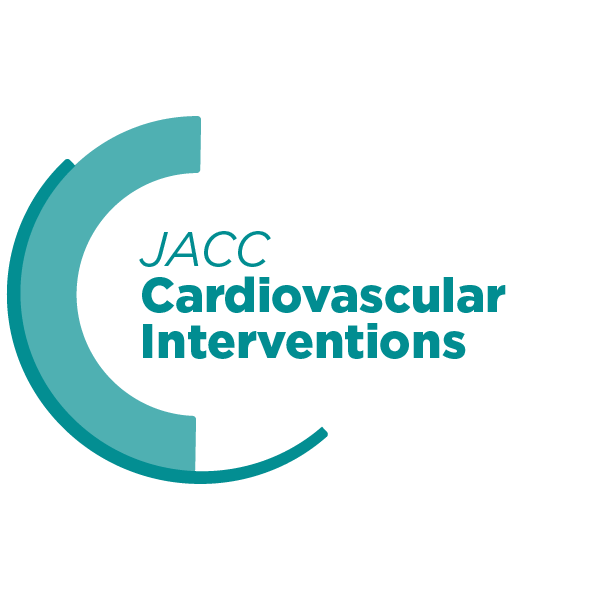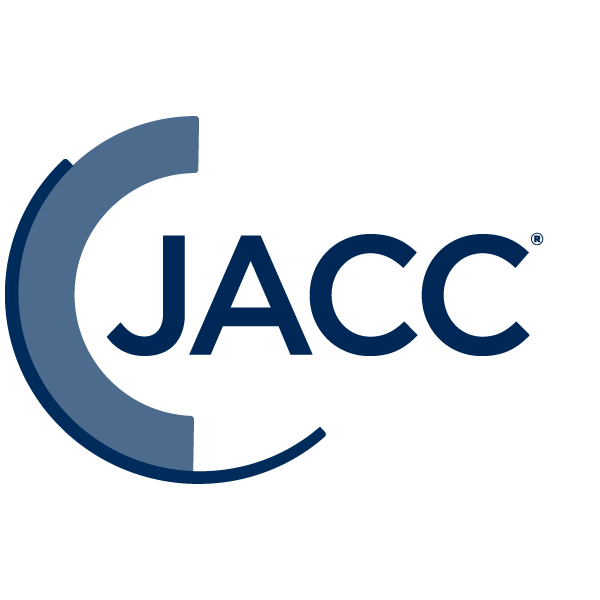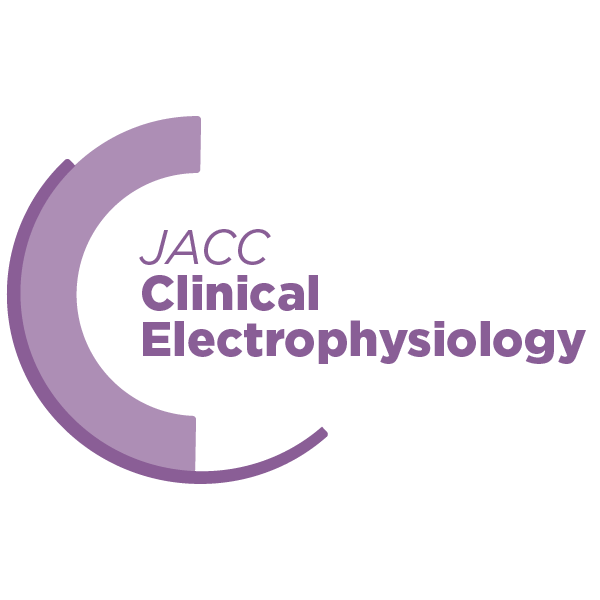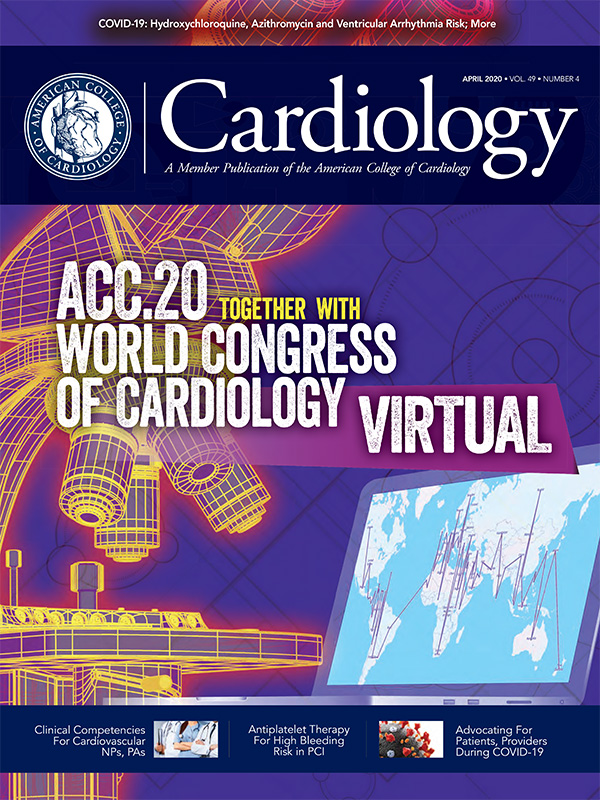JACC in a Flash
Featured topics and Editors' Picks from all of ACC's JACC Journals.
Imaging Investigations Yield New Insights For CAD, BAV, Machine Learning

Three studies presented during ACC.20/WCC and published in JACC: Cardiovascular Imaging provide new insights for understanding plaque morphology in coronary artery disease (CAD); the rate and predictors of aortic regurgitation (AR) progression in patients with bicuspid aortic valve (BAV); and applying machine learning for identifying phenogroups in heart failure.
A study using optical coherence tomography (OCT) for in vivo coronary plaque mapping in three vessels found that the distribution of thin-cap fibroatheroma (TCFA) was not uniform, with proximal clustering in all three coronary arteries, particularly the left anterior descending (LAD). In contrast, fibrous plaque was relatively evenly distributed through the entire length of each coronary artery. Furthermore, the study found more clustering of TCFA in the LAD, right coronary artery and circumflex artery in patients with acute coronary syndrome (ACS), and more prevalent in the area with greater luminal narrowing.
The authors of this large, single-center registry of 131 patients with de novo CAD note that the findings in their study are in line with other recent studies that demonstrated cross-sectional stenosis severity correlated with prevalence of TCFA.
In an accompanying editorial comment, Yukio Ozaki, MD, FACC, highlights similarities and differences in findings in this study with OCT and others using pathologic or angiographic studies to understand lesion morphology and severity. While acknowledging the difficulty in reconciling the apparent similarities and differences, obtained with different imaging techniques/specimens/methodologies in different populations/clinical presentations, he states "there is consensus that TCFAs are more prone to plaque rupture and tend to be more prevalent in the proximal segments of coronary arteries."
A retrospective study of patients with stage B BAV who had surgery found that 32% of the 157 patients (48 years old; 78% men) progressed to stage C/D within a median of approximately three years. Robust predictors of progression independent of severity of AR were male sex, root-complex dilatation (annulus/STJ) and R-N phenotype. The authors suggest that patients with BAV and these characteristics should have TTE follow-up sooner than the recommended three to five years.
Another study identified four distinct phenotypic clusters using automated computational methods, with patients in each cluster showing clinical presentations based on ACC/AHA heart failure stage and the occurrence of short-term major adverse cardiac and cerebrovascular events.
In what the authors say is the first successful application of a "phenomics" approach to effectively integrate multiple conventional and unconventional echocardiographic parameters of left ventricular structure and function, it was possible to identify cardiac phenogroups in terms of clinical presentation, cardiac structure and function, hemodynamics, and outcomes. Such an approach is needed to secure the promise of precision medicine.
"It is remarkable that the authors used automated machine learning platforms to derive and validate disease phenotypes," write Edgar Argulian MD, MPH, FACC, and Jagat Narula MD, DM, PhD, MACC, in an accompanying editorial. They note that larger studies with longer follow-up would allow eventual model outcome comparisons and confirmation, inclusion of diverse sets of patients with different cardiac disease spectrums will allow evaluation of model generalizability, and assessments after treatments in specific patient phenotypes will allow understanding of the extent of phenotypic reversibility in the disease loop.
References
- Araki M, Soeda T, Kim HO, et al. JACC: Cardiovasc Imaging 2020;March 16:[Epub ahead of print].
- Yang L-T, Pellikka PA, Enriquez-Sarano M, et al. JACC: Cardiovasc Imaging 2020;March 16:[Epub ahead of print].
- Cho JS, Shrestha S, Kagiyama N, et al. JACC: Cardiovasc Imaging 2020;March 16:[Epub ahead of print].
Conscious Sedation Associated With Improved TAVR Outcomes vs. General Anesthesia

The use of conscious sedation for TAVR may be associated with improved outcomes compared with general anesthesia, according to results of a study presented during ACC.20/WCC and published in JACC: Cardiovascular Interventions.
Using data from the STS/ACC TVT Registry, Neel M. Butala, MD, MBA, et al., looked at the relationship between conscious sedation vs. general anesthesia and TAVR outcomes based on hospital proportion of conscious sedation use. The researchers also examined variations in the use of conscious sedation for TAVR across hospitals and over time. The primary outcome was in-hospital mortality. Secondary outcomes included 30-day mortality, procedural success, hospital length of stay, use of inotropic drugs and discharge home.
The final sample included 120,080 patients from 559 sites who underwent TAVR between 2016 and 2019. In adjusted analyses, in-hospital mortality was 1.1% among TAVR patients receiving conscious sedation vs. 1.3% among those receiving general anesthesia. In addition, conscious sedation was associated with lower 30-day mortality, shorter hospital stays, less use of inotropic drugs and more frequent discharge home. There was no difference in procedural success between conscious sedation and general anesthesia.
The proportion of sites using conscious sedation increased from 50% to 76% during the study period, while the proportion of TAVR procedures performed with conscious sedation increased from 33% to 63%. There was wide variation in use of conscious sedation across hospitals. In the final 12 months of the study, 43% of sites performed more than 80% of TAVR cases with conscious sedation, while 17% of sites performed no cases with conscious sedation.
According to the researchers, use of conscious sedation for TAVR has increased, although substantial hospital-level variations remain. The study suggests that conscious sedation for TAVR is associated with improved outcomes compared with general anesthesia, they note. Conscious sedation "should be considered the preferred approach to anesthesia for the vast majority of patients undergoing TAVR," they conclude.
References
- Butala NM, Chung M, Secemsky EA, et al. JACC: Cardiovasc Interv 2020;March 16:[Epub ahead of print].
SPARCL: Atorvastatin Reduces First, Subsequent Vascular Events

In patients with no known coronary heart disease who had a recent stroke or transient ischemic attack, intensive atorvastatin therapy, vs. placebo, reduced the first occurrence of stroke and the first composite vascular events, according to results from the SPARCL study presented during ACC.20/WCC and published in the Journal of the American College of Cardiology.
This post hoc analysis examined the first and total (first and subsequent) vascular events in 4,731 participants who were randomized to atorvastatin 80 mg daily vs. placebo. The primary efficacy endpoint of SPARCL was time to occurrence of the first fatal or nonfatal stroke.
Results showed with placebo there were 41.2 first and 62.7 total vascular events per 100-participants over six years, and with atorvastatin there were 164 fewer first and 390 fewer total vascular events (total events hazard ratio, 0.68; 95% confidence interval 0.60 to 0.77). For total event reduction, with atorvastatin there were 177 fewer cerebrovascular, 170 fewer coronary, and 43 fewer peripheral events. An estimated 20 vascular events per 100-participants were avoided using the atorvastatin treatment.
Overall, write the authors, the total number of vascular events prevented with atorvastatin was more than twice the number of first events prevented, which included significant reductions in total cerebrovascular, total coronary, and total peripheral events.
"Future trials of intensive lipid-lowering strategies should compare treatment effects on disease burden, as quantified by total vascular events, in high-risk patient populations," they write.
Looking ahead, they write, "Given these observations, reduction in total events may be considered another important measure reflecting the clinical benefit and efficiency of atorvastatin treatment in reducing disease burden in this setting."
References
- Szarek M, Amarenco P, Callahan A, et al. J Am Coll Cardiol 2020;March 16:[Epub ahead of print].
COAPT Trial Update: Short-Term Health Status Changes Associated With Long-Term Clinical Outcomes

In patients with heart failure (HF) and severe secondary mitral regurgitation (SMR), a short-term change in disease-specific health status was associated with subsequent long-term risk of death or HF hospitalization, according to results from the COAPT study presented during ACC.20/WCC and published in the Journal of the American College of Cardiology.
Suzanne V. Arnold, MD, MHA, et al., examined the association between change in health status from baseline to one month and the composite rate of death or HF hospitalization between one month and two years among patients in COAPT, and examined whether treatment with transcatheter mitral valve repair (TMVr) vs. guideline-directed medical therapy (GDMT) alone affected this association.
Results showed improvement in short-term, patient-reported disease-specific health status was independently associated with lower risk of subsequent death or HF hospitalization between one month and two years. Patients treated with TMVr were more likely to achieve a ≥10-point improvement in health status from baseline to one month (TMVR 58% vs. GDMT alone 26%). However, researchers found the association of health status changes with long-term outcomes did not differ by treatment assignment.
"[The] data suggest that serial assessments of health status in patients with HF and severe SMR – particularly around times of medical intensification or interventional therapy – may be beneficial to identify patients with a potentially improved prognosis or, conversely, those who remain at high risk for poor outcomes," the researchers concluded.
References
- Arnold SV, Stone GW, Mack MJ, et al. J Am Coll Cardiol 2020;March 16:[Epub ahead of print].
CVC, AVP Effective for CIED Implantation; May Offer Fewer Complications Compared With SVP

Cephalic vein cutdown (CVC) and axillary vein puncture (AVP) are effective approaches for cardiac implantable electronic device (CIED) implantation and may offer a lower risk of complications, compared with subclavian vein puncture (SVP), according to a study presented during ACC.20/WCC and published in JACC: Clinical Electrophysiology. Varunsiri Atti, MD, et al., reviewed 23 studies comparing SVP, AVP and CVC to evaluate the efficacy and safety of venous access techniques for CIED implantation.
All studies with individuals age 18 and older with at least one month of follow-up that evaluated the efficacy and safety of SVP/AVP with CVC and reported at least one clinical outcome of interest were included. The primary outcomes of interest were complications (pneumothorax, device/lead failure, pocket hematoma/bleeding and device infection), acute procedural success, and total procedure time.
The researchers then conducted a meta-analysis using a random effects model to calculate risk ratios and mean differences.
The 23 studies included 35,722 patients (SVP, 18,009 patients; AVP, 409 patients; and CVC, 17,304 patients). Compared with CVC, SVP was associated with a higher risk of pneumothorax (risk ratio [RR], 4.88; 95% confidence interval [CI], 2.95 to 8.06) and device/lead failure (RR, 2.09; 95% CI, 1.07 to 4.09).
No significant difference were seen in these outcomes compared with AVP. In addition, acute procedural success was significantly higher with SVP compared with CVC (RR, 1.24; 95% CI, 1.00 to 1.53). No significant differences were seen in complications such as pocket/hematoma, device infection or pericardial effusion between SVP or AVP compared with CVC.
According to the researchers, CVC is associated with a lower risk of pneumothorax and lead failure than SVP. CVC or AVP are "both effective approaches for CIED lead implantation and have the potential to avoid complications usually observed with traditional SVP," they conclude.
References
- Atti V, Turagam MK, Garg J, et al. JACC: Clin Electrophysiol 2020;March 16:[Epub ahead of print].
Study Provides Framework For Modern Metrics in Disseminating CV Imaging Research

Modern metrics along with traditional citations are needed to measure the impact of published research papers in the field of cardiovascular imaging and understand the evolving interests of readership, according to research presented at ACC.20/WCC and simultaneously published in JACC: Cardiovascular Imaging.
Historically, dissemination trends in medical journals have been assessed through numbers of citations. Accurate numbers for citations can emerge several years after research is published, thus do not assess the early impact on readership. Social media, Altmetrics and other modern metrics provide a more detailed picture of the interests of clinical readership.
Andrew D. Choi, MD, FACC, et al., sought to measure the impact value of Altmetrics, citations and downloads by examining the most impactful studies across the spectrum of cardiovascular imaging over a three-year period (2017-2019) and determine the long-term scientific merit of articles with high Almetrics. The researchers provide a framework for how to incorporate these metrics for a modern approach to dissemination.
"SoMe [social media] influencers may guide Altmetric trends by discussing publications influenced by an individual's own practice environment, visual appeal, or even simply attention for its own sake. Additionally, negative attention to an article may be weighted similarly to positive attention by Altmetrics, making the appropriate scientific merit of the paper confounded," the authors write.
The authors found that "[the] highest impact articles are those that are both shared broadly and cited, while articles shared broadly also demonstrate readership impact."
"What is trending on SoMe may not always become scientifically impactful by citation (and not absent its own inherent risks and challenges; "moth to the flame?"). Yet, assessing trends while keeping aim on lasting impact are not mutually exclusive but complementary goals," the authors conclude.
References
- Choi AD, Gesje JB, Lopez-Mattei JC, et al. JACC: Cardiovasc Imaging 2020;March 16:[Epub ahead of print].
ACC Survey Emphasizes Need For More Formalized Training in Advanced CV Imaging

As the field of cardiovascular imaging has matured, there may be a growing need for more formalized training pathways and standardized competencies through advanced cardiovascular imaging training programs, according to survey results published in JACC: Cardiovascular Imaging.
Gaby Weissman, MD, FACC, et al., analyzed results from the ACC Cardiovascular Imaging Program Directors' Survey, expanding upon previous work to comprehensively characterize the current state of advanced cardiovascular imaging training programs. The survey was sent to the program directors of 66 advanced cardiovascular imaging training programs in the U.S. and Canada, and was open from March to April 2019.
Survey results showed that despite lack of Accreditation Council for Graduate Medical Education recognition, advanced cardiovascular imaging trainees (n=151) represent a large pool of trainees, comparable with other cardiac subspecialties such as interventional cardiology (n=339), clinical cardiac electrophysiology (n=259), and advanced heart failure and transplantation (n=105).
Furthermore, the survey found that most advanced cardiovascular imaging program directors (72%) do not favor the current state of imaging certification where each modality has its own certification exam. It also discovered that funding and time protection remains a significant challenge, as the majority of programs rely on institutional or departmental funding and most program directors have minimal protected time for their roles.
"Advanced cardiovascular imaging programs and their trainees are a large but heterogeneous cohort of cardiovascular subspecialists with unique challenges in both training and subsequent clinical practice," the authors conclude. "It is time for the advanced cardiovascular imaging community to work together and identify collaborative solutions for this unique cardiovascular subspecialty."
References
- Weissman G, Lee J, Sivaram CA, et al. JACC: Cardiovasc Imaging 2020;March 16:[Epub ahead of print].
Higher MV Surgery Volumes May Not Be Associated With Better TMVr Outcomes

Higher institutional volume of mitral valve (MV) surgeries may not be associated with better outcomes following transcatheter mitral valve repair (TMVr), according to a study published in JACC: Cardiovascular Interventions.
Colin M. Barker, MD, FACC, et al., examined the relationship between institutional MV procedural volumes and outcomes in Medicare patients. The researchers sought to confirm a positive relationship between institutional MV surgery volume and patient outcomes and examine whether TMVr outcomes were related to either MV surgery or TMVr institutional volumes.
Hospital volumes were categorized into three groups based on annual MV surgery volume (low, 1 to 24 procedures; medium, 25 to 39 procedures; and high, 40 or more procedures) and TMVr volume (low, 1 to 18 procedures; medium, 19 to 51 procedures; and high, 52 or more procedures). The researchers assessed outcomes by looking at in-hospital mortality, six-month post discharge mortality, and six-month cardiovascular rehospitalizations.
The results confirmed the relationship between MV surgery volume and in-hospital mortality but did not find statistically significant relationships between either MV surgery or TMVr volume and TMVr outcomes. Patients undergoing MV surgery at low- or medium-volume institutions had higher in-hospital mortality compared with those undergoing surgery at high-volume institutions.
According to the researchers, the lack of relationship between institutional MV procedure volumes and TMVr outcomes suggests that higher surgical volumes is not related to better transcatheter outcomes. The findings do not support increasing annual MV surgery volumes required to start a TMVr center, they conclude.
References
- Barker CM, Reardon MJ, Reynolds MR, Feldman TE. JACC: Cardiovasc Interv 2020;March 16:[Epub ahead of print].
Clinical Topics: Acute Coronary Syndromes, Noninvasive Imaging, Pericardial Disease, Valvular Heart Disease, Atherosclerotic Disease (CAD/PAD), Mitral Regurgitation
Keywords: ACC Publications, Cardiology Magazine, Ischemic Attack, Transient, Length of Stay, Hospital Mortality, Coronary Artery Disease, Aortic Valve Insufficiency, Plaque, Atherosclerotic, Retrospective Studies, Conscious Sedation, Acute Coronary Syndrome, Cross-Sectional Studies, Tomography, Optical Coherence, Patient Discharge, Constriction, Pathologic, Axillary Vein, Patient Discharge, Hospital Mortality, Social Media, Subclavian Vein, Benchmarking, Pneumothorax, Confidence Intervals, Pericardial Effusion, Medicare, Odds Ratio, Mitral Valve Insufficiency, Electrophysiologic Techniques, Cardiac, Follow-Up Studies
< Back to Listings


